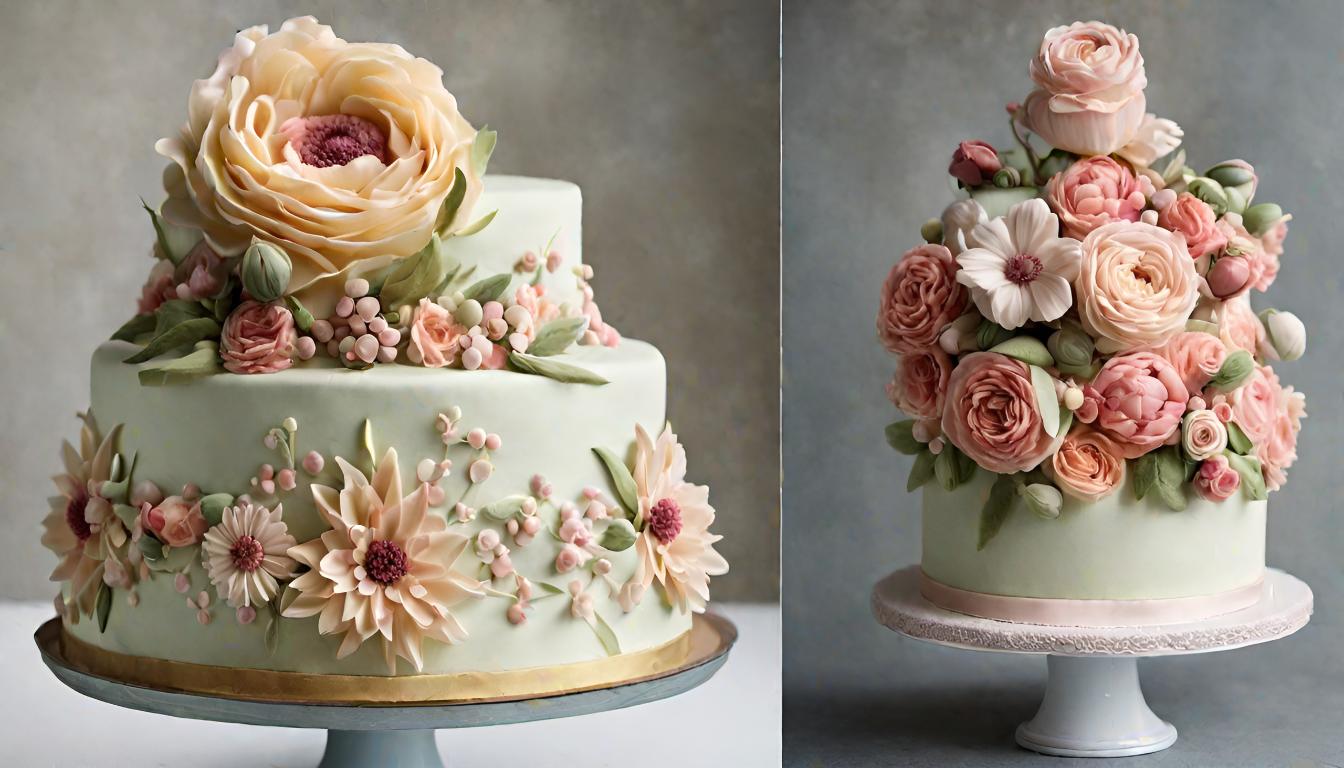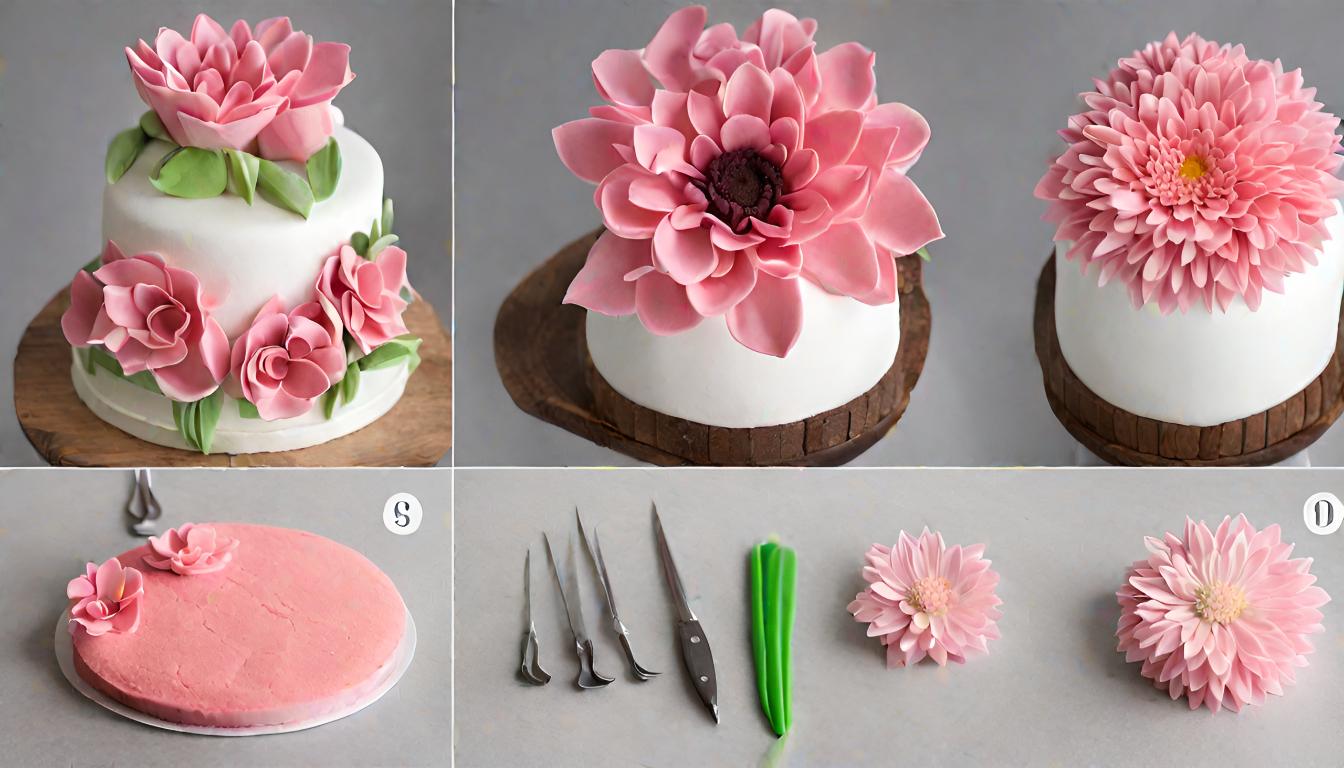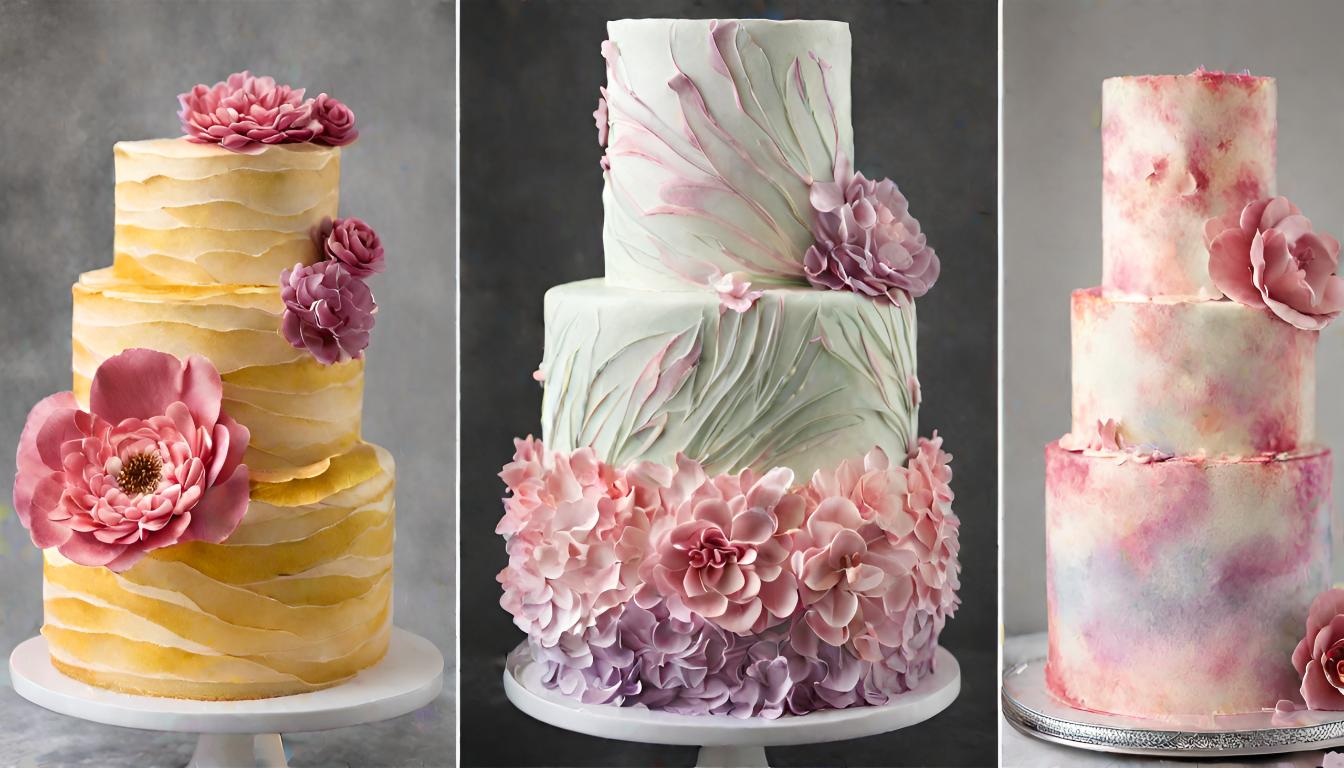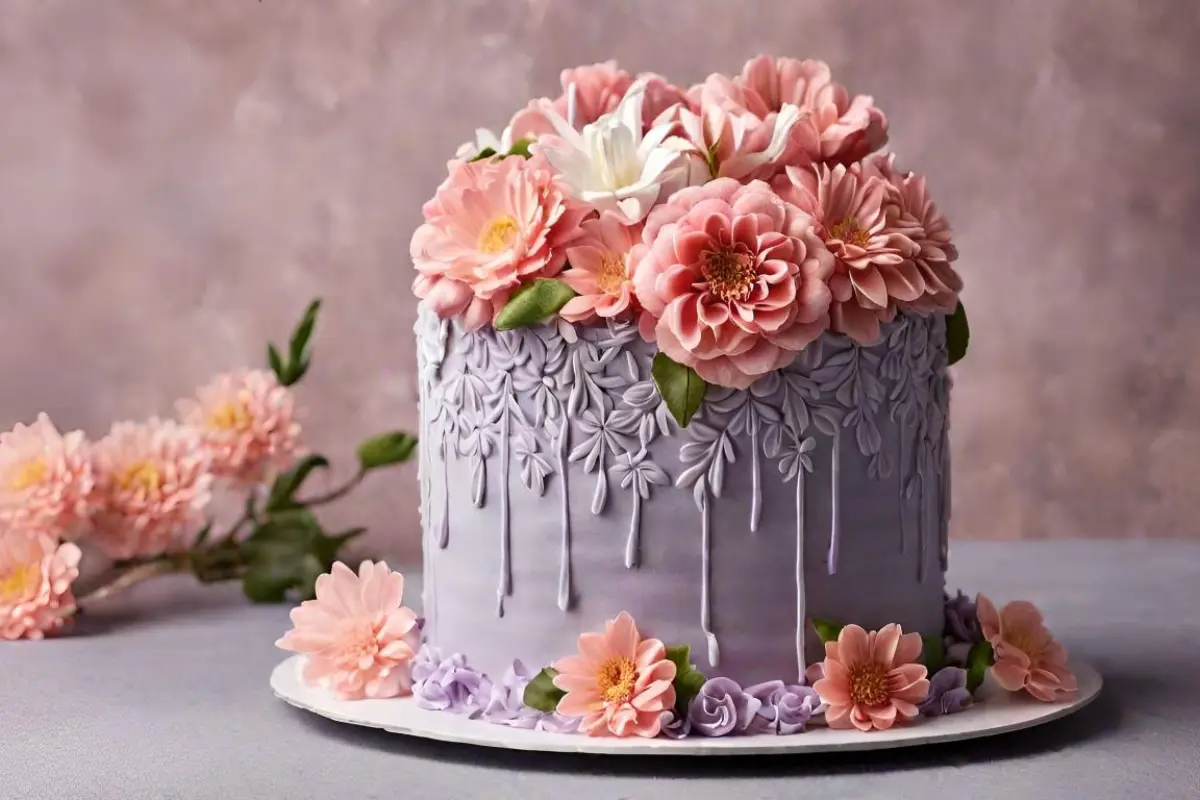Embark on a delightful journey into the enchanting world of flower cake, where the artistry of baking and the beauty of floral design converge. This article delves into the various aspects of flower cakes, from their historical roots to modern decorating techniques, offering insights and inspiration for both baking enthusiasts and curious readers alike.
Introduction to Flower Cake
Exploring the Art of Flower Cakes
Flower cakes represent a beautiful fusion of culinary skill and artistic expression. These cakes are not just desserts; they are edible masterpieces, where the delicate beauty of flowers is recreated with icing, fondant, and an array of decorative techniques.
The Beauty and Elegance of Floral Designs in Baking
The allure of flower cakes lies in their intricate designs and the skillful imitation of nature’s beauty. Each petal, leaf, and bloom crafted in sugar is a testament to the baker’s artistry. These cakes are often the centerpiece of celebrations, admired for both their aesthetic appeal and delicious taste.
Why Flower Cakes Have Captured Our Hearts
Flower cakes have a special place in the world of baking. They symbolize elegance, creativity, and the joy of celebration. Whether it’s a wedding, anniversary, or a springtime tea party, flower cakes add a touch of beauty and sophistication that is simply captivating.
In the next part, we’ll explore the historical roots of flower cakes, tracing their origins and understanding their cultural significance.
Stay tuned as we delve into the rich history of flower cakes, uncovering how this beautiful art form has evolved over time. Whether you’re a seasoned baker or just appreciate the beauty of edible art, this journey through the history of flower cakes is sure to be both enlightening and inspiring. For those interested in the fundamentals of baking, Martha Stewart’s Baking Basics offers a great starting point.
History and Significance
The Historical Roots of Flower Cakes
The tradition of flower cakes has a rich and varied history, intertwining with the evolution of baking and cake decorating over the centuries.
Tracing the Origins of Floral Decorations in Baking
Floral designs in baking can be traced back to ancient times when natural flowers were used to adorn cakes for special occasions. As baking techniques evolved, especially with the advent of sugarcraft in the 17th century, bakers began to create edible flowers as decorations. This art form gained popularity, particularly in Europe, where intricate sugar flowers became a symbol of culinary sophistication.
Cultural Significance of Flowers in Cake Design
Flowers have long been a symbol of beauty, celebration, and sentiment, making them a perfect adornment for cakes meant for special occasions. Different cultures have incorporated floral designs into their baking traditions, each adding a unique touch to the art of flower cake decoration. In modern times, flower cakes have become a staple in weddings, anniversaries, and other celebratory events, symbolizing elegance, festivity, and the beauty of nature.
In the next part, we’ll explore the various types of flower cakes, from buttercream flower cakes to fondant flower creations, and the unique characteristics of each style.
Stay tuned as we delve into the different varieties of flower cakes, showcasing the diversity and creativity in this art form. Whether you’re planning to bake your own flower cake or simply admire the beauty of these edible artworks, our upcoming section will provide a comprehensive look at the types of flower cakes you can explore. For those seeking creative inspirations, Serious Eats’ Cake Recipes offer a wide range of ideas.

Types of Flower Cakes
Varieties of Flower Cakes
Flower cakes come in various forms, each with its own charm and set of techniques. Let’s explore some of the most popular types.
Buttercream Flower Cakes – A Delicate Craft
Buttercream flower cakes are a testament to the skill of the baker. Using buttercream icing, artists pipe intricate flowers that are as beautiful as they are delicious. These cakes often feature a variety of flowers, such as roses, peonies, and chrysanthemums, each piped to perfection.
Fondant Flower Cakes – Sculpting with Sugar
flower cakes take the art to a different level. Fondant, a pliable sugar paste, is used to create lifelike flowers and leaves. These cakes are known for their smooth finish and realistic floral arrangements. The versatility of fondant allows for a wide range of creativity, from elegant roses to exotic orchids.
In the next part, we’ll dive into the step-by-step process of creating a flower cake. From selecting the right tools and ingredients to mastering the techniques for crafting beautiful flowers, we’ll cover everything you need to know to make your own flower cake masterpiece.
Stay tuned as we share a comprehensive guide to making your own flower cake. Whether you’re a novice baker or looking to refine your skills, our upcoming section will provide valuable tips and techniques to help you create a stunning flower cake. For expert cake decorating tips, Wilton Cake Decorating offers a wealth of resources.

Step-by-Step Guide to Creating a Flower Cake
Crafting a flower cake is a journey through the art of baking and decorating. Let’s break down the process into manageable steps.
Essential Tools and Ingredients
Before starting, ensure you have the right tools and ingredients. You’ll need:
- Baking Tools: A good quality mixer, baking pans, spatulas, and cooling racks.
- Decorating Tools: Piping bags, various piping tips (especially for petal and leaf shapes), fondant tools, and food coloring.
- Ingredients: Basic cake ingredients (flour, sugar, eggs, butter), buttercream icing, and fondant.
Techniques for Crafting Beautiful Flowers
- Bake the Cake: Start by baking your cake layers. Choose a flavor that complements the floral design.
- Prepare the Icing: Make a smooth buttercream icing for piping. Color it in shades that match your flower choices.
- Pipe Buttercream Flowers: Using a petal tip, pipe flowers onto parchment paper. Start from the outer petals, working inward. Chill them until firm.
- Roll and Shape Fondant: For fondant flowers, roll out the fondant and use cutters or tools to shape petals and leaves. Let them dry to hold their shape.
- Assemble the Cake: Once the cake layers are cool, stack and frost them. Gently place the buttercream and fondant flowers onto the cake.
- Add Final Touches: Use leaves and small blossoms to fill gaps and add a realistic touch to your floral arrangement.
In the next part, we’ll explore various decorating tips and tricks to enhance your flower cake. From advanced techniques for realistic flowers to ideas for color palettes and arrangements, we’ll provide insights to elevate your cake decorating skills.

Decorating Tips and Tricks
Mastering the Art of Flower Cake Decoration
Decorating a flower cake is where your creativity truly shines. Let’s look at some advanced techniques and ideas for stunning arrangements.
Advanced Techniques for Realistic Flowers
- Layering Petals: For a more realistic look, layer petals of varying sizes and shades. This technique adds depth and dimension to your flowers.
- Veining on Petals: Use veining tools or even toothpicks to create delicate lines on fondant petals, mimicking the natural veins of real flowers.
- Dusting for Color: Enhance the realism of your flowers by lightly dusting them with edible petal dust. This adds subtle color variations and depth.
Color Palettes and Arrangement Ideas
- Choosing a Color Scheme: Select a color palette that complements your cake’s flavor and the occasion. Soft pastels are great for spring and weddings, while vibrant colors suit festive celebrations.
- Arranging Flowers: Place larger blooms first and fill in gaps with smaller flowers and leaves. Consider the cake’s shape and size for a balanced look.
- Incorporating Greenery: Don’t forget to add greenery for contrast. Leaves and vines can break up the floral arrangement and add a touch of elegance.
In the next part, we’ll dive into some creative inspirations for your next flower cake. From themed designs to seasonal motifs, we’ll provide a range of ideas to spark your imagination.
Stay tuned as we explore a variety of creative inspirations for flower cakes. Whether you’re looking for ideas for a specific event or just want to try something new, our upcoming section will offer a wealth of ideas to fuel your creativity. For those seeking innovative cake recipes, Serious Eats’ Cake Recipes provides a diverse collection to explore.

Inspirational Ideas
Creative Inspirations for Your Next Flower Cake
Drawing inspiration for your flower cake can come from many sources, from nature to art, offering endless possibilities for design and creativity.
Themed Flower Cake Ideas
- Seasonal Themes: Embrace the seasons with your flower cake designs. Spring cakes can feature bright, blooming flowers, while autumn cakes might showcase warmer tones and fall foliage.
- Occasion-Specific Designs: Tailor your flower cake to the occasion. Elegant roses for anniversaries, playful daisies for birthdays, or sophisticated peonies for weddings.
Seasonal Flower Cake Designs
- Spring Blossoms: Use pastel colors and delicate flowers like cherry blossoms or tulips to capture the essence of spring.
- Summer Vibrance: Opt for bright, bold colors and flowers like sunflowers or hibiscus to reflect summer’s energy.
- Autumn Elegance: Incorporate rich, warm colors with flowers like dahlias or marigolds to evoke the coziness of autumn.
- Winter Sophistication: Create a winter wonderland with white and silver flowers, adding elements like pinecones or holly for a festive touch.
In the next part, we’ll address some of the most common questions about flower cakes. From preparation tips to storage advice, we’ll provide answers to the queries that enthusiasts of this delightful art form frequently ask.
Answering Common Questions About Flower Cakes
Let’s dive into some of the most common queries about this beloved form of cake artistry.
- How Long Does It Take to Make a Flower Cake?
- The time can vary greatly depending on the complexity of the design. Simple flower cakes might take a few hours, while more intricate designs could require a day or more, especially if you include drying time for fondant flowers.
- Can Flower Cakes Be Made in Advance?
- Yes, flower cakes can be made in advance. Buttercream flowers can be piped ahead and stored in the freezer, while fondant flowers can be made days before and kept in a cool, dry place.
- What Are the Best Ways to Preserve Flower Cakes?
- To preserve the cake, keep it in a cool area away from direct sunlight. If it’s not being served immediately, refrigerate it, especially if it has buttercream flowers.
- Are Edible Flowers Safe for Cake Decorating?
- Yes, but ensure they are pesticide-free and meant for culinary use. Common edible flowers include roses, pansies, and lavender. Always verify the safety of the flowers you intend to use.
- Can You Use Real Flowers on Cakes?
- Real flowers can be used, but they must be non-toxic and free from pesticides. It’s also advisable to use a barrier between the cake and the flowers, such as placing the stems in flower picks or wrapping them in floral tape.
In the final part of our article, we’ll wrap up with some concluding thoughts on the enduring charm of flower cakes. We’ll recap the key points and leave you with some final reflections on this delightful form of cake decoration.
Continuing our exploration of flower cakes, we now address some frequently asked questions. This section aims to provide valuable insights and practical advice for both enthusiasts and curious newcomers alike.
Part 7: FAQs
Answering Common Questions About Flower Cakes
Let’s dive into some of the most common queries about this beloved form of cake artistry.
- How Long Does It Take to Make a Flower Cake?
- The time can vary greatly depending on the complexity of the design. Simple flower cakes might take a few hours, while more intricate designs could require a day or more, especially if you include drying time for fondant flowers.
- Can Flower Cakes Be Made in Advance?
- Yes, flower cakes can be made in advance. Buttercream flowers can be piped ahead and stored in the freezer, while fondant flowers can be made days before and kept in a cool, dry place.
- What Are the Best Ways to Preserve Flower Cakes?
- To preserve the cake, keep it in a cool area away from direct sunlight. If it’s not being served immediately, refrigerate it, especially if it has buttercream flowers.
- Are Edible Flowers Safe for Cake Decorating?
- Yes, but ensure they are pesticide-free and meant for culinary use. Common edible flowers include roses, pansies, and lavender. Always verify the safety of the flowers you intend to use.
- Can You Use Real Flowers on Cakes?
- Real flowers can be used, but they must be non-toxic and free from pesticides. It’s also advisable to use a barrier between the cake and the flowers, such as placing the stems in flower picks or wrapping them in floral tape.
In the final part of our article, we’ll wrap up with some concluding thoughts on the enduring charm of flower cakes. We’ll recap the key points and leave you with some final reflections on this delightful form of cake decoration.
Conclusion
The Enduring Charm of Flower Cakes
Flower cakes are more than just desserts; they are a celebration of artistry, creativity, and the beauty of nature, all expressed through the medium of baking and cake decoration.
Recap and Final Thoughts
- A Blend of Art and Culinary Skill: Flower cakes represent the perfect marriage of artistic design and culinary expertise, showcasing the baker’s ability to transform simple ingredients into stunning floral displays.
- Versatile and Adaptable: Whether you’re creating a buttercream bouquet or a fondant floral arrangement, flower cakes offer endless possibilities for customization, making them suitable for any occasion.
- A Joyful Celebration: These cakes bring joy and beauty to any event, from weddings and anniversaries to birthdays and seasonal gatherings.
In closing, flower cakes are not just a treat for the palate but also a feast for the eyes. They embody the spirit of celebration and the joy of baking, making every occasion they grace a little more special.
As we reach the conclusion of our delightful exploration into the world of flower cakes, let’s take a moment to reflect on the unique charm and appeal of these edible masterpieces.
Conclusion
The Enduring Charm of Flower Cakes
Flower cakes are more than just desserts; they are a celebration of artistry, creativity, and the beauty of nature, all expressed through the medium of baking and cake decoration.
Recap and Final Thoughts
- A Blend of Art and Culinary Skill: Flower cakes represent the perfect marriage of artistic design and culinary expertise, showcasing the baker’s ability to transform simple ingredients into stunning floral displays.
- Versatile and Adaptable: Whether you’re creating a buttercream bouquet or a fondant floral arrangement, flower cakes offer endless possibilities for customization, making them suitable for any occasion.
- A Joyful Celebration: These cakes bring joy and beauty to any event, from weddings and anniversaries to birthdays and seasonal gatherings.
In closing, flower cakes are not just a treat for the palate but also a feast for the eyes. They embody the spirit of celebration and the joy of baking, making every occasion they grace a little more special.
We hope this journey through the world of flower cakes has inspired you to either try your hand at creating your own or simply to appreciate the artistry involved in their creation. Remember, the beauty of a flower cake lies not just in its appearance but also in the love and care that goes into making it. So, whether you’re a seasoned baker or a newcomer to the world of cake decorating, embrace the challenge and enjoy the sweet rewards of your efforts. For those seeking innovative cake recipes, Serious Eats’ Cake Recipes provides a diverse collection to explore.

